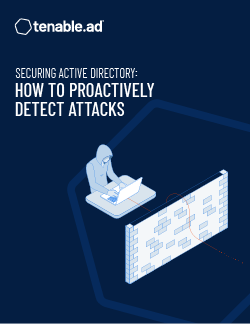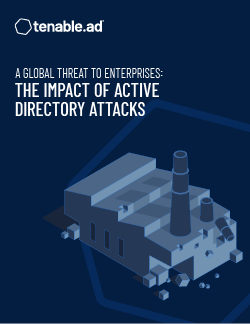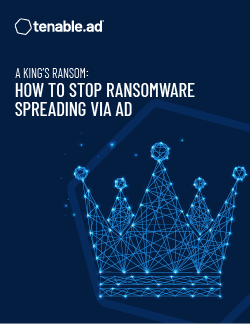Everything You Need to Know about Active Directory Security
Your How-to Guide to Find and Fix Active Directory Security Vulnerabilities and Eliminate Attack Paths
Active Directory security encompasses the people, processes and tools your organization uses to identify vulnerabilities, misconfigurations, and other security issues within your Active Directory. IT administrators use Active Directory, a Microsoft Windows directory service, to manage a range of functions including applications, users, and other components of your network. Active Directory is a key tool for identity and access management.
Many organizations overlook Active Directory even though it’s a target that bad actors want to breach to gain access to your systems and then move laterally throughout your network. As such, Active Directory security is an important part of your overall cybersecurity program, helping to protect your sensitive data, applications, systems, user credentials, and other network aspects from potential breaches.
In this Active Directory knowledgebase, we’ll share with you more information about what Active Directory is, how your organization can use it, and best practices for securing your Active Directory and including it as part of your overall risk-based vulnerability management program.

Here are a few highlights of what you’ll find:
Top 10 Active Directory Security Questions CISOs Must Ask
Do you know what to look for in an Active Directory security solution? Here are the top 10 questions every CISO should ask.
Learn MoreSecure Active Directory and Eliminate Attack Paths
Do you know how to discover and prioritize your Active Directory risks? Watch this webinar to learn how.
Learn MoreActive Directory FAQ
Here are some frequently asked questions about Active Directory and Active Directory security.
Learn MoreActive Directory Attack Path
Attackers want access to your Active Directory so they can move laterally, escalate privileges and take over your domain in minutes.
Learn MoreTenable Active Directory Community
Tenable’s Active Directory Community is a great place to talk with other professionals about common AD issues and tools.
Learn MoreTenable Identity Exposure for Active Directory Security
Tenable Identity Exposure can help you find and fix all of your Active Directory weakness in real-time and proactively prevent attacks
Learn MoreSecure Your Active Directory to Eliminate Attack Paths
Tenable Identity Exposure Helps you See, Predict and Act to Proactively Address Active Directory Vulnerabilities
When successfully breached, your Active Directory can be a gateway for attackers looking to make lateral movements through your network, often undetected. Unfortunately, Active Directory security is an often-overlooked, but important part of securing your enterprise. With Tenable Identity Exposure, you can quickly find and fix Active Directory vulnerabilities, eliminate attack paths, prevent lateral movement, and stop privilege escalation before a breach happens.

Securing Active Directory: How to Proactively Detect Attacks
Attackers have a sophisticated approach to Active Directory attacks, an attack pathway often overlooked by organizations, even those with a relatively mature cybersecurity program. And even for organizations that are aware Active Directory can come under attack their traditional approach to security just doesn’t work well for Active Directory.
Over the years, Microsoft has offered up some security solutions for on-premises Active Directory security, but few, if any, of them have had the sticking power for organizations to commit to them. Instead, they’re often short-lived or replaced with other solutions. While other security solutions have edged into the market over the past two decades, for example, group policy management, they just don’t offer true, comprehensive security for your Active Directory environment. That’s because new attacks are complex and often hidden and detection isn’t always easy.
Most Active Directory solutions were created a decade or so ago and they just haven’t kept up with the changing Active Directory environment which now encompasses more assets and more diverse asset types. While some solutions like AD monitoring or SIEM may alert if they uncover an issue, few can proactively detect a wide array of attacks, preventing your organization from taking action to fix misconfigurations or other issues.
Tenable Identity Exposure, however, doesn’t need an attack log before it can alert you to issues. Instead, it uses your raw AD replication stream to find problems before a successful breach.
In this white paper, learn more about other common Active Directory security challenges and find out how Tenable Identity Exposure can help you conquer them, including:
- How attacks use misconfigurations for privileged access
- How you can discover misconfigurations in your Active Directory
- How to employ proactive solutions that work across all of your Active Directory installations
A Global Threat to Enterprises: The Impact of Active Directory Attacks
Active Directory, in its very nature, is a single point of failure, and we’re seeing the number of Active Directory attacks around the globe increase in both volume and severity. Active Directory attacks are a threat to all global enterprises, regardless of industry.
In this white paper, take a closer look at some of today’s most common Active Directory risks and the potentially catastrophic impacts they can have on organizations, including a closer look at 15 significant corporate breaches and best practices to protect your Active Directory from similar attacks.
You can also explore five high-level risks that your organization should make a priority to address, including the impact of Active Directory attacks on business continuity, brand damage and customer trust, and competitive loss and IP threats. This white paper also offers practical tips to help your organization implement effective Active Directory security, including the adoption of automation tools and real-time event monitoring.
A King's Ransom: How to Stop Ransomware Spreading via Active Directory
Security breaches are expensive and cost businesses as much as $170 bullion every year. In 2019 alone, hacking cost the U.S. about $3.5 billion. Attackers know Active Directory holds the keys to your kingdom, so they’re continuously looking for ways to infiltrate your systems through AD and laterally move unnoticed.
One of attackers’ favorite methods is ransomware deployment through Active Directory, where organizations, on average, pay about $84,000 in ransom following a successful breach. But your Active Directory doesn’t have to be vulnerable to these attacks. In this white paper, you can take a deeper dive into how you can prevent ransomware spread through your Active Directory with six quick tips to protect access to your privileged Active Directory accounts.
Tenable Connect community: Your go-to resource for active directory security
Do you have questions about Active Directory security? Do you need help building Active Directory security into your existing cybersecurity program? Tenable Connect is a great place to connect with others interested in Active Directory security. Join them and explore some common challenges and great solutions for today’s pressing Active Directory security needs.
Here are some sample conversations happening now:
LDAP searches returning only 1000 result
When performing Active Directory/LDAP searches for assets or users in Tenable Security Center, you may encounter situations where there is only a maximum of 1000 results returned regardless of the actual number of users/assets that match the query in LDAP/Active Directory.
Read MoreLogin Type Shown as (authentication: password) When Failing to Login with an LDAP User Account
If you set up an LDAP user account and then change the case of the username, that will break the Tenable Security Center connection to that Active Directory user account. When that user attempts to login, it will fail.
Read MoreWhich mobile technology is supported by Tenable?
Integrations are available with the following MDM systems: Exchange 2010 or later (via Active Directory); Apple Profile Manager as shipped with Mac OS X 10.7 server; MobileIron; AirWatch; and Good for Enterprise.
Read MoreFrequently Asked Questions about Active Directory Security
Are you new to active directory security? Do you have questions about active directory vulnerabilities and risks but not sure where to start? This FAQ is a great place to begin:
What is Active Directory?
What is Active Directory used for?
What is Active Directory security?
What is an Active Directory object?
What are the three main components of Active Directory security?
What is an Active Directory domain?
What is an Active Directory tree?
What is an Active Directory forest?
What are the five roles in Active Directory?
What does an Active Directory schema master do?
What does an Active Directory domain naming master do?
What does the Active Directory RID master do?
What does a PDC emulator do in Active Directory?
What does an Active Directory infrastructure master do?
What types of groups are in Active Directory security?
Why do I need Active Directory security?
What are common services in Active Directory?
What is identity and access management?
Is Active Directory a tool?
What are some benefits of Active Directory security?
Blog

Disrupting the Pervasive Attacks Against Active Directory and Identities
If you want to prevent attackers from being able to move laterally within your network and escalate privileges, then you should include Active Directory security into your risk-based approach to cybersecurity. If an attacker successfully gets access into your Active Directory, they’re likely to seek out high-level privileges so they can get access to more information and move deeper into your systems, creating backdoor access that is often unnoticed. Tenable Identity Exposure, however, shines a light on these hidden pathways, giving your organization opportunities to stop attacks before they happen including insight into new admin account creation, permission changes, new trust relationships, and more.

Securing Active Directory: 3 Ways to Close the No-Password Loophole
Active Directory has a number of security issues attackers can exploit, including negating password requirements with a simple command, something commonly missed during routine security reviews and audits. This blog explores three simple ways you can secure accounts including creating a saved query in Active Directory with a custom LDAP, using the PowerShell module, continuously monitoring all users to ensure none are set up to not require a password.

Securing Active Directory: How to Prevent the SDProp and adminSDHolder Attack
Did you know that attackers can get access to your Active Directory by using the SDProp process and then gain privileges through your adminSDHolder object? Attackers know that if they have a rogue user or group to adminSDHolder ACL, when your SDProp process runs, they can get access to every privileged user and group automatically, sometimes even adding them back 60 minutes after being discovered and having the user or group removed. Who has time for that much manual monitoring though? The good news is Tenable Identity Exposure can handle it for you, constantly evaluating your attack pathways and alerting you when there’s a new one.

The Top 10 Active Directory Security Questions CISOs Must Ask
Although it’s been around for more than 20 years, Active Directory has been adaptable to meeting changing business needs, which is visible in its increased adoption and usage. But unfortunately, many organizations using Active Directory don’t know how to properly secure it, and many don’t know what they need when they’re looking for an Active Directory security solution. This blog takes a deeper dive into the top 10 questions every CISO should ask before finalizing your short-list for a new Active Directory security solution. With careful planning, you can ensure your organization selects a solution that is both resilient and can scale with you over time.
Tenable Identity Exposure
Weak and misconfigured settings are a gateway for attackers wanting to get access into your Active Directory so they can make lateral movements and escalate privileges, often without you knowing they’re there. You can prevent and detect Active Directory attacks simply, with automation, with Tenable Identity Exposure.
Visibility
NGet unparalleled visibility into your Active Directory environment so you can discover all your vulnerabilities, misconfigurations, and security issues.
Prioritization
Understand which Active Directory security risks should get your attention first and follow a step-by-step guide for remediation
Reduce Cyber Exposure
Reduce your Active Directory exposures in real time with continuous and automated new attack pathway detection
Real-Time Detection
Discover and defend against attacks in real time without needing agents or privileges
See Tenable Identity Exposure in Action
Continuously detect and respond to Active Directory attacks in real time. No agents. No privileges. Stop lateral movement. Prevent privilege escalation. On-prem and cloud-based options available.
- Tenable Identity Exposure

